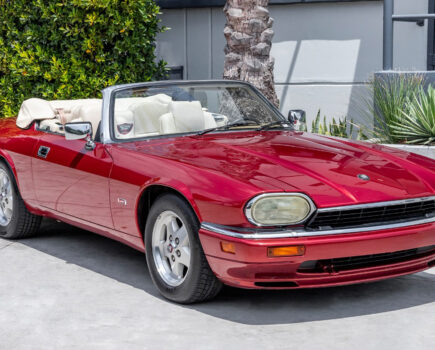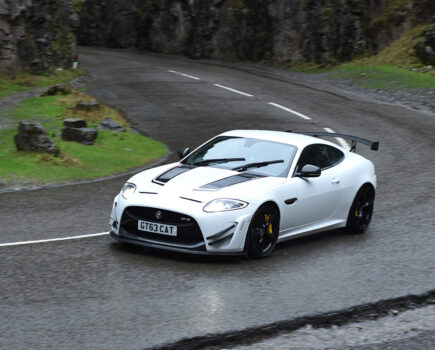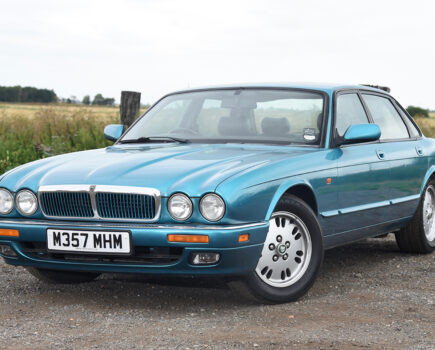We go camping in the very north of Scotland to check both the fuel efficiency and practicality of the new mild hybrid XF Sportbrake 2.0-litre diesel
Words: Paul Walton
Now that the views are starting to look like a scene from Game of Thrones, except with more lay-bys and supermarket delivery vans, the Scottish Highlands are a visual reminder of just how far I’ve driven. Even at around 420 miles so far, I still have another 200 to go before l can relax, although I use the word in the broadest possible sense.
To discover both the economy and practicality of the recently facelifted XF Sportbrake, powered by Jaguar’s new mild hybrid drivetrain, I’m travelling to Thurso and the most northerly campsite in the British mainland, a location so far away I’m beginning to think GoT’s Westeros might have been easier to get to after all.
With more than 600 miles to cover, I leave home at ‘stupid o’clock’ – otherwise known as 5am. Stowed behind me is my pop-up tent, plus an electric cool box (plugged into the rear compartment’s 12v socket), a camping stove, kettle and all the other paraphernalia I’ll need for a night under canvas. Admittedly, it’s just me that’s tenting, but at 565 litres (1,675 with the seats down, a mere 65 fewer than an F-Pace) the XF Sportbrake’s boot swallows it all with room to spare. While increased space, ride height and practicality might currently make SUVs the world’s most popular variety of car, making up 44 percent of the European market in 2020, the XF Sportbrake proves that traditional estates shouldn’t be discounted for anyone wanting an increased load space without compromise on styling.
I especially think this Firenze Metallic Red (a £700 option) example with its handsome 19in seven-spoke ‘Style 7013’ wheels with a contrast diamond-turned finish (£800) is particularly pretty. The XF Sportbrake’s 2020 refresh didn’t change much, but the wider front grille featuring a mesh design apparently inspired by Jaguar’s Heritage logo and a new front bumper with larger and lower air intakes do just enough to keep the now six-year-old car relevant for a while longer. However, because it is taller and wider than the first generation of Sportbrake, I can’t help but feel the current model has lost the original’s svelte ‘shooting brake’ style, the increased size making the car appear more akin to something that the Germans (with their typical straightforwardness) would call a ‘wagon’.
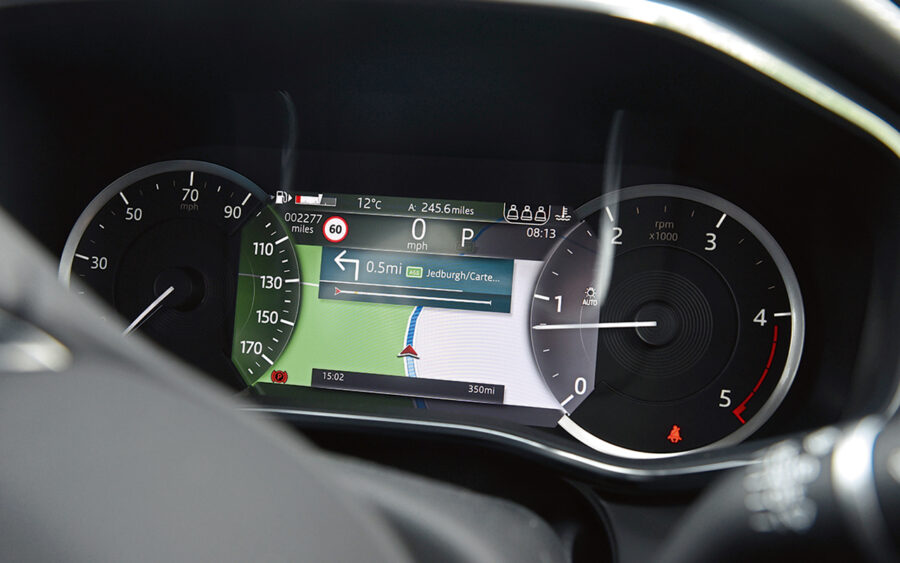
I join the A1 north and push the throttle hard. As a mild hybrid electric vehicle (or MHEV), the D200 has Jaguar’s new 204PS (201bhp) 2.0-litre diesel engine, plus a small electric motor on the rear axle that assists the engine when accelerating. Unlike the E-Pace P300e PHEV, which I tested in the previous issue (p52), the XF Sportbake cannot be driven on the 48V lithium-ion battery alone.
The battery, located beneath the rear loadspace, can only be recharged via a belt integrated starter generator (BiSG) in the engine bay that harvests the energy during slowing and braking. It’s unnoticeable when the electric motor joins the diesel engine, resulting in a creamy smooth surge of acceleration. Yet despite its two sources of power, the car feels sluggish and can be hard to get moving from slow speeds, the throttle needing to be constantly worked hard to keep momentum.
There will be plenty of times during the trip when I fall way behind the traffic ahead by not concentrating on the pedal. Weight is clearly a factor. The combination of the XF Sportbrake being physically bigger, the electric engine, the battery, plus this version having all-wheel drive, means that despite being all aluminium it weighs 1,931kg, over 100kg more than the old, steel-framed 2.2-litre model, and it always feels it.
The road is unsurprisingly quiet at this time of the morning. Two hours and 160 miles after leaving home in the East Midlands I reach Scotch Corner, the historic junction where the Great North Road meets what we now call the A66. It was made famous by a mention in Jethro Tull’s 1976 song, Too Old to Rock ‘n’ Roll, Too Young to Die about a biker taking one last ride.
So the old rocker gets out his bike,
To make a ton before he takes his leave,
Up on the A1 by Scotch Corner,
Just like it used to be
I pull into the services for a coffee – its price making me wish it really was like it used to be – and check the satellite navigation screen on the new 11.4in touchscreen that now dominates the dash. Looking and feeling like a tablet, it controls Jaguar’s new Pivi Pro system. Although the map is clear and easily manipulated using a ‘pinch and pull’ action, I find the new system complicated. Admittedly, I don’t have as much experience using it as I do of the old InControl Touch Pro, but it takes me ten minutes to swap between music streaming and the DAB radio.
From here, there are three main ways to reach Scotland. Firstly, across the Pennines on the A66 and then north on the M6; secondly, continue along the A1 until Edinburgh; finally, take the A68 that cuts through Northumberland. I choose the latter.
I join the road from the A1 just outside that jewel of the north, Darlington, and after passing through West Auckland (the winner of what’s considered to be the first football World Cups in 1909 and 1911 – seriously, look it up), I’m soon surrounded by majestic views of the Northumberland National Park. Since the 128-mile road is single carriageway all the way to the Scottish capital, it’s the slowest of the three routes, but the many blind summits, fast corners and bleak scenery make it more of an adventure than tackling Ben Nevis in tennis shoes.
On the endless dips and turns, the 2.0-litre diesel engine again needs to be worked hard to keep the revs high, but the constant road signs reporting how many accidents there have been on the A68 over the last few years is a grave reminder of its danger and not to go crazy. Not that the car would allow me to.
Almost 250 miles after leaving home, I cross the border into Scotland at Carter Bar; at 1,371ft (418m) above sea level, it gives clear views across both countries. Once the scene of the 1575 Raid of the Redeswire, one of the last large-scale battles between the English and the Scots, today Carter Bar is a nondescript carpark full of holiday makers. I guess that’s called progress.
I know something else that’s progress; the astounding economy of the XF Sportbrake. When I check the fuel gauge, the tank is still more than half full and the trip says it’s covering 45mpg (as it would for the rest of the journey). Old news for some manufacturers, I know, but Jaguar has only relatively recently made economy a priority. If I were in an XJ12 Series 3 I’d have drained the entire North East of England of all available unleaded.
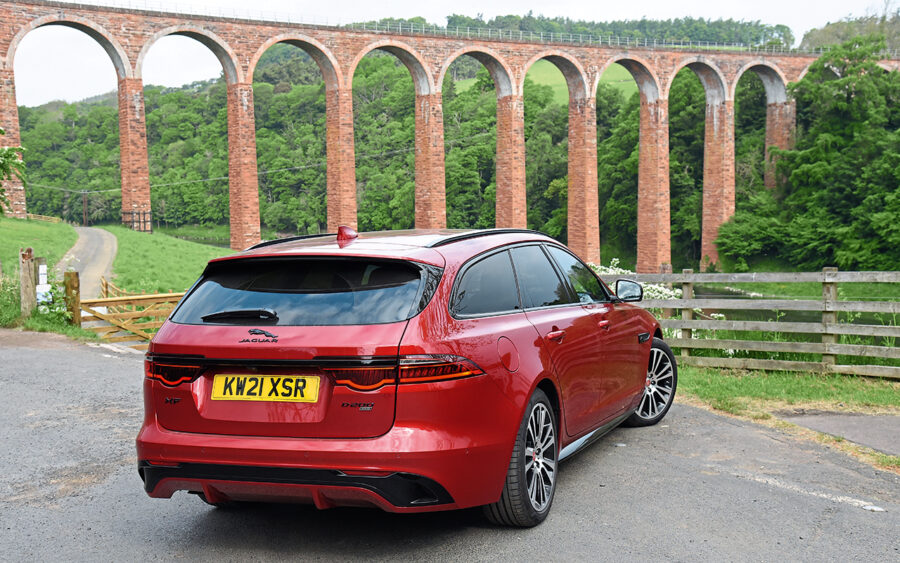
A few miles outside Jedburgh – a pretty border town dominated by the substantial ruins of a 12th century abbey – I cross the River Tweed, the modern bridge giving magnificent views of the 18-arch Leaderfoot Viaduct from the mid 19th century. Once carrying a single track for the Berwickshire railway, today it’s unused and there is no public access.
Less than an hour after leaving the old bridge, I take Edinburgh’s ring road towards a new one. Opened in August 2017, the Queensferry Crossing is the third bridge to span the Firth of Forth and replaces the 1964 Forth Road Bridge for motorway traffic. At 1.7 miles, it’s the longest triple-tower cable-stayed bridge in the world. Originally known as the unromantic Forth Replacement Crossing, its eventual slightly less imaginative name was selected by a public vote in 2013. Personally, I’d have chosen The Third of Forth. Or Bridgey McBridgeface.
After a 35-mile dash along the M90, I pick up the A9, literally the backbone of Scotland. For 273 miles, the road snakes its way through central, eastern and northern Scotland before ending at Thurso. Mainly single carriageway, the many campervans, lorries and speed cameras make it slower than the M25 at rush hour.
Only on the occasional stretch of dual carriageway is it safe to overtake, although the pause after I squeeze the throttle before the power arrives soon becomes tiresome and I apologise to the driver of a Mazda Bongo Friendee who gave me a rude gesture for not overtaking him quicker. Unless he simply doesn’t like the car. Or my haircut.
After 400 miles and seven hours of constant travelling, I enter the Highlands, the scenery quickly morphing from flat, treelined and boring into magnificent peaks as far as I can see, snow still evident on the dark tops despite it being early June.
The views might have changed but the road hasn’t; the A9 feels longer than the endless rom-coms my wife makes me watch. Thankfully, the XF Sportbrake’s wide and supportive seats, plus generous legroom, make the car ideal for long journeys like this and my backside isn’t (yet) feeling the result of so many miles. This £37,415 R-Dynamic S (£41,320 as tested here) has plenty of useful equipment, and, as well as the usual suspects, there’s also a wireless charging area under the touchscreen for a phone (a £300 option).

Plus the fit, finish and materials used have all taken a giant leap forward over the pre-facelift models (including the D180 saloon that I took to Scafell Pike in the March 2021 issue, p84). The XF Sportbrake now feels like the genuinely solid, luxurious car it was always meant to be; if you’re looking to trade in your old XJ for something of comparable quality, look no further.
I don’t like the new gear selector, though. Replacing the simple-to-use rotary dial that was initially seen in the first XF in 2007, as per the F-Type’s joystick-style shifter you now need to push down for drive and up for reverse which confuses me more than algebra. Plus, the system doesn’t like to be rushed. Push down too quickly and the eight-speed transmission doesn’t always engage drive, especially annoying during a three-point turn.
At Inverness, the road starts to follow the North Sea and I’m treated to some awe-inspiring scenery made even better by the bright sunlight that’s illuminating the usually dark water and craggy cliff faces. For a moment, I imagine I’m in the south coast of France, the last thing I was expecting while on the north coast of Scotland. But, although I’m getting close to my destination, this isn’t the final surprise the journey has to offer.
At the tiny village of Latheron (derived from the Scottish Gaelic Latharn or ‘muddy place’ – a name equally suitable for my son’s PE kit bag), the A9 leaves the coast and cuts through the centre of Caithness. The countryside might have become as bland and featureless as porridge – the only distinguishable features being a forest of slowly turning wind turbines – but the long straights and fast, clear corners make the 23-mile stretch of road one of the greatest I’ve ever driven.
Although the XF Sportbrake is clearly too big, too heavy and not powerful enough to be driven hard (plus my tin mug has become loose and is now clanking around the boot), with all-wheel-drive finding plenty of grip and the lack of body roll, the car can cut through bends with surprising efficiently. And, when I pull the gear selector down once again into sport mode, which allows the engine to rev harder and for longer, and use the aluminium steering-wheel-mounted gear paddles that give me even further control, the engine finally comes alive. It could do with another 50bhp, but, by reacting quicker, I can still power out of a fast corner with ease. I subsequently keep the car in sport for the return journey.
Twenty minutes of exhilarating driving later, I cruise into the most northerly town on the British mainland, Thurso; Oslo is closer than London by 50 miles. The campsite, Windhaven, is another ten minutes along the coast, located in the tiny hamlet of Brough (rhymes with loch), the most northerly village in the British mainland to be reached by a numbered road, the B855, and a mere three miles from Dunnet Head, the mainland’s most northerly point. According to Wikipedia, Brough has a population of just 66 meaning it’s less cosmopolitan than even Slough, but it does offer some amazing views over the North Sea. The campsite overlooks a tall rock stack called Little Clett that rises dramatically out of the sea like a prehistoric monster. I’d hate to meet Big Clett.

The view isn’t the only thing that amazes me. Since leaving home what seems like weeks ago, I’ve covered 620 miles yet the range monitor still says there’s another 50 miles left in the tank. Considering it also emits a polar-bear friendly 150g/km of CO2, it makes the XF MHEV reasonably clean and economical for such a big car. Admittedly, an I-PACE would have got me here with less emissions than a hard-puffing cyclist, but thanks to long charging times and the lack of charging points (I didn’t see any along the A9), instead of the 12 hours it’s taken me today, it would probably have taken more like 12 days to do the same journey.
I understand where Windhaven gets its name from the moment I open the door. I need to use more tent pegs than a circus big top to stop me becoming Little Clett’s one and only inhabitant. After a dinner of cold beans (my lighter wouldn’t ignite; why couldn’t I have discovered whether the XF Sportbrake is economic enough to reach a luxury hotel instead?) I go to sleep not only thinking about whether my tent could be swept away at any moment, like Dorothy’s house in The Wizard of Oz, but also about the car that brought me here.
Although not perfect – the 2.0-litre engine could do with another 50bhp and the return of the old rotary selector, plus it’s about as exciting to drive as my wife’s ten-year-old Ford Focus – by being beautifully built, reasonably practical and incredibly economical, the XF Sportbrake D200 is ideal for those long adventurous getaways. Just remember to take matches.






















